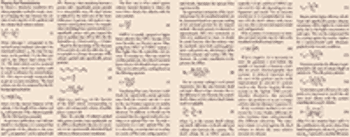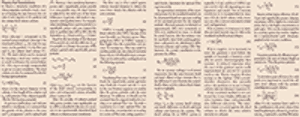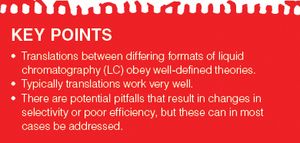
The success of screening column and mobile phase combinations that generate dissimilar selectivity is highlighted in a typical method development strategy.
Patrik Petersson is a principal scientist at Ferring Pharmaceuticals.

The success of screening column and mobile phase combinations that generate dissimilar selectivity is highlighted in a typical method development strategy.

This review article summarizes the results obtained from the combined efforts of a joint academic and industrial initiative to solve the real-life challenge of determining low levels of peptide-related impurities in the presence of the related biologically-active peptide at a high concentration.

Retention time fluctuations are challenging to deal with, especially in two-dimensional liquid chromatography (2D‑LC) separations. Here, two approaches are presented that can help navigate this challenge.

Retention time fluctuations are challenging to deal with, especially in two-dimensional liquid chromatography (2D-LC) separations. Here, two approaches are presented that can help navigate this challenge.

In this installment, tips, tricks, and suggestions are provided for best practices in reversed-phase separations, in both 1D and 2D LC, with gradient elution for minimum variations in retention time.

The effect of dwell volume on chromatographic selectivity can be successfully modelled using retention prediction software. Hence, the robustness of reversed-phase LC gradient methodologies, with respect to dwell volume, can be conveniently assessed.

Chromatographic principles and best practices for obtaining highly precise retention time, peak width, and resolution predictions for the optimization of reversed-phase liquid chromatography (LC) separations using retention modelling software will be discussed. The importance of fully characterizing the LC instrumentation, how to generate accurate input data, the selection of appropriate models, and peak tracking will be addressed along with a suggested workflow. Adhesion to a few basic rules and simple precautions and the use of modern retention modelling software programmes can assist the rapid development of highly accurate retention models to enable the development of robust and optimized reversed-phase LC separations using either ultrahigh-pressure liquid chromatography (UHPLC) or high performance liquid chromatography (HPLC) conditions. Examples of retention modelling for small and large molecules will be highlighted.



The approach described here will help chromatographers produce highly efficient method development strategies for reversed-phase LC separations in a relatively short time frame.

The selectivity of different combinations of organic modifiers, pH, and types of reversed-phase liquid chromatography (LC) materials has been characterized using Tanaka column characterization, linear solvent energy relationships (LSER), and selectivity correlations. The three characterization techniques highlighted the potential complementary selectivity of these phases and conditions as well as the type and dominancy of some of the retention mechanisms involved. Subsequently, selectivity differences were proven to be valid in the practical separation of acids, bases, and neutral analytes. This paper aims to assist chromatographers in producing highly efficiency method development strategies for reversed-phase LC separations in a relatively short time frame.

The numerous advantages of translating gradient chromatographic methods between the differing formats of LC have been explored and discussed. While translations in principle obey well defined chromatographic theories, the authors investigate a number of potential pitfalls that may result in poor translations as exhibited by selectivity differences, changes in efficiency, and hence failure to meet resolution system suitability criteria.

The numerous advantages of translating gradient chromatographic methods between the differing formats of LC have been explored and discussed. While translations in principle obey well defined chromatographic theories, the authors investigate a number of potential pitfalls that may result in poor translations as exhibited by selectivity differences, changes in efficiency, and hence failure to meet resolution system suitability criteria.

When transferring a method between HPLC and UHPLC, various potential pitfalls may result in selectivity differences, changes in efficiency, and failure to meet resolution system suitability criteria.

Published: September 1st 2023 | Updated:

Published: June 1st 2022 | Updated:

Published: May 1st 2022 | Updated:

Published: August 1st 2014 | Updated:

Published: March 1st 2015 | Updated:

Published: June 12th 2015 | Updated: